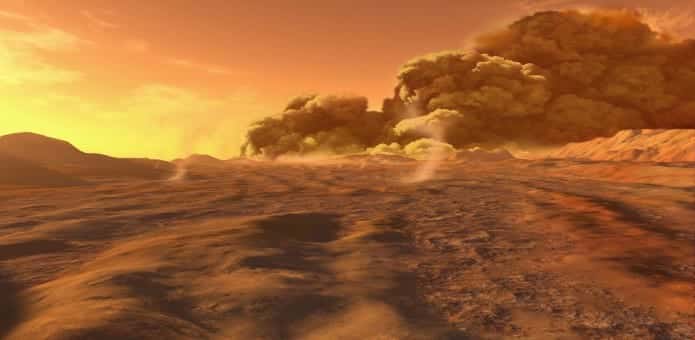Table Of Contents
Understanding the facts and fiction of dust storms with NASA’s help
What actually happens in a Martian dust storm, does it really have the potential to leave an astronaut stranded on Mars?
Science fiction movie “The Martian” based on the novel written by Andy Weir is going to be released soon. The much awaited movie begins with a massive dust storm which leaves an astronaut stranded on Mars.
In the movie it has been shown that a powerful wind rips an antenna out of a piece of equipment and destroys parts of the astronaut’s camp.
In response NASA has tried to explain certain facts and fiction of the Martian atmosphere in a recent blog post.
According to NASA experts, it is true that Mars experiences ‘annual dust storms’ and for decades they have been observing these dusty Martian storms through the telescopes from the surface of Earth. It seems these dusty storms can last for weeks and also cover continent sized areas. Besides, some of them could be really intense and massive, hence scientists refer to these storms as “global dust storms”.
In the blog post, Michael Smith, a planetary scientist at NASA’s Goddard Space Flight Center in Greenbelt, Maryland, says: “Once every three Mars years (about 5 ½ Earth years), on average, normal storms grow into planet-encircling dust storms, and we usually call those ‘global dust storms’ to distinguish them.”
However, NASA experts also believe that in real life the Martian dust storm is not strong enough to leave any person stranded in the storm.
In the blog, NASA clearly mentions that, “Even the wind in the largest dust storms likely could not tip or rip apart major mechanical equipment. The winds in the strongest Martian storms top out at about 60 miles per hour, less than half the speed of some hurricane-force winds on Earth.”
The Martian atmosphere is merely 1 percent dense which is quite less in comparison to that of Earth’s atmosphere. Hence, even though Martian dust storms are able to stir enough dust which can be seen from the telescopes placed on Earth’s surface there is definitely a marked difference in the intensity of the storms on both the planets.
In the blog, NASA mentioned that according to physicist William Farrell, who has been studying Martian dust storm, “The key difference between Earth and Mars is that Mars’ atmospheric pressure is a lot less.” He also added: “So things get blown, but it’s not with the same intensity.”
In the attached video, we can see Weir talk with the employees of Google, way back in 2014 where he has humorously mentioned that basically the book is fictional and even he is aware that a dust storm on the Red planet is unlikely to strand an astronaut. He says:
“I tried to make the book as accurate as I could. The biggest place that’s inaccurate – don’t tell anybody – but if you’re in a dust storm on Mars, you’re not even going to feel it. Mars’ atmosphere is less than one percent of Earth’s. So a 150-km/hour wind would feel like about a 1-km/hour wind does on Earth. It wouldn’t do any damage to anything. Shhh …
Most people don’t know how Martian dust storms work, that it’s not like being in a sandblaster. It’s just more dramatic that way. So I just made that concession. [shrugs and smiles] I know I’m a liar. I just … wanted that.”
The two major facts regarding Martian dust storm which Weir has mentioned in his book and which scientists also believe to be true are:
The individual dust particles on Mars, which are quite small and have electrostatic properties due to which they stick to the surface which come in contact with. Smith says: “If you’ve seen pictures of Curiosity after driving, it’s just filthy. The dust coats everything and it’s gritty; it gets into mechanical things that move, like gears.”
Another major impact of Martian dust is seen on the solar panels. NASA says: “Even dust devils of only a few feet across — which are much smaller than traditional storms — can move enough dust to cover the equipment and decrease the amount of sunlight hitting the panels. Less sunlight means less energy created. In The Martian, Watney spends part of every day sweeping dust off his solar panels to ensure maximum efficiency, which could represent a real challenge faced by future astronauts on Mars. Global storms can also present a secondary issue, throwing enough dust into the atmosphere to reduce sunlight reaching the surface of Mars. When faced with a larger dust storm in the book, Watney’s first hint is the decreased efficiency of his solar panels, caused by a slight darkening of the atmosphere. That’s a pretty accurate depiction of what large dust storms can do…”
It is pretty clear that NASA engineers have to take into consideration all these facts when they are actually designing the spacecrafts and equipment for Mars.
Also, this is a science fiction novel and movie, and NASA has made it pretty clear that the Martian dust storm cannot strand an astronaut; however it is also a fact that the dusty storm has its own consequences on the spacecraft which needs to be taken in to account.

